Regional podcasts find their voice
Homegrown non-music audio startups have been seeing a tremendous increase in user base since the lockdown, but getting people to pay for content and becoming self-sustaining are big challenges. Accord


 (Left to right) Khabri co-founders Sandeep Singh, Aankit Roy, COO Dushyant Kohli and co-founder Pulkit Sharma. The non-music audio platform, which aggregates content across categories like news, government jobs, philosophy, leadership and motivation, has seen a 350 percent month-on-month growth since the lockdown in March
(Left to right) Khabri co-founders Sandeep Singh, Aankit Roy, COO Dushyant Kohli and co-founder Pulkit Sharma. The non-music audio platform, which aggregates content across categories like news, government jobs, philosophy, leadership and motivation, has seen a 350 percent month-on-month growth since the lockdown in March
Image: Madhu Kapparath
When Yogendra Saini, aka ‘Technical Yogi’, received his first paycheck of Rs 8,300 from YouTube in 2017 for his videos on gadget reviews, technology news and tips for people in small-town India to build a social media presence, it was motivation enough for him to leave a career in journalism to create videos full-time. The resident of Alwar, Rajasthan, taught himself how to professionally shoot and edit videos, “sometimes through continuous trial and error till 3 or 4 am” and invested in a DSLR. He even worked on his performance skills and made an effort to write engaging scripts. As his popularity grew, the 33-year-old had numerous people reaching out to him for guidance on how to launch a digital channel and make money out of it.
Saini felt like he had to teach these people what he knew, but there were several problems: Many people did not have smartphones with good picture quality, the skills or resources to edit videos, or even the confidence required to face the camera. The women from small towns and villages who reached out to him, Saini says, “had the passion, drive and the talent to be successful content creators, but were not allowed by their families to make videos”.
So in late 2018, when he came across Khabri, a recently-launched non-music audio platform, he decided to use the emerging digital medium to expand his audience base, and help people who could not create videos to capitalise on audio instead. The increasing number of people accessing audio platforms became evident when Saini did his first audio live on Khabri. “Within minutes, over 1,000 people joined in and started asking me questions. It was impossible to answer all of them,” he says.
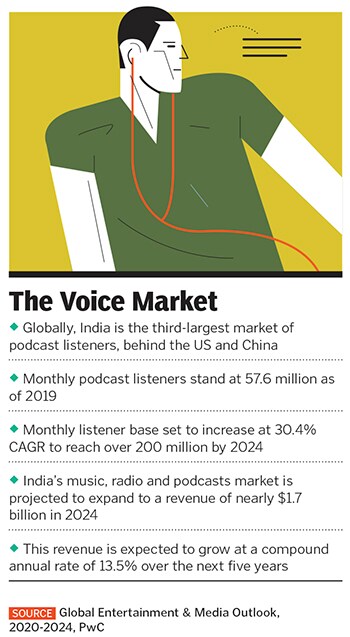
He admits that the visibility received through video and audio is not comparable at present: His YouTube channel Technical Yogi, has a million subscribers as of October, and his most popular videos have received over 2 million views. His podcast channel, on the other hand, has about 12,000 followers, and close to 291,000 listens.
While explaining that his video channel had almost a two-year headstart over audio, Saini believes that voice-based content is the future, and diligently creates at least one or two podcasts every week even though he does not earn money out of it yet. “India has openly embraced new technology, taking one giant leap after another very quickly. Just like we have developed a strong demand for video over the past few years, the obvious next step is to turn to audio because it is cheaper and more convenient. It’s just a matter of time,” he says.
Saini might be onto something here, since startups in the non-music audio space are reporting that things have been looking up for them. The Covid-19 pandemic, founders say, has been pushing digital consumption across various forms of media, increasing demand for audio content.
Khabri, for instance, has been registering a 350 percent month-on-month growth since the lockdown in March, the company claims. Co-founder Pulkit Sharma tells Forbes India that they had around 200,000 monthly active users before the lockdown, which has increased to over 700,000 now. The number of content creators on-boarded by the platform has increased from 15,000 in March to more than 45,000 in just the past six months.
A couple of recent global developments are bringing audio back into the big money game after it had been relegated as a medium that could not equal the popularity of and preference for video, says Sharma. “Globally, Spotify has spent more than $400 million in non-music audio, acquiring podcast networks like Anchor and Gimlet [in 2019]. In China, audio streaming startup Ximalaya FM is a unicorn [valued over $1 billion] and is engaging users up to two hours every day,” he explains. “The biggest companies in the world, including Microsoft, Apple and Google, are investing in building podcasting platforms. The next tech war will be over voice.”
India has the third-largest listener base for podcasts in the world after the US and China, according to the Global Entertainment & Media Outlook, 2020-2024, published by PwC in October. Although it might not be much on a per capita basis, the report states that the number of monthly listeners is expected to see a compound annual growth rate (CAGR) of 30.4 percent over the next five years, going from 57.6 million in 2019 to over 200 million by 2024. The music, radio and podcast industry in India is expected to have a revenue of nearly $1.7 billion in 2024, at a CAGR of 13.5 percent.
Favourable Tide
“There is a blue ocean opportunity for audio in India, because it is the one medium that gets to capitalise on the time that the user is not looking at her phone,” says Gautam Raj Anand, founder and CEO of Hubhopper, a platform that creates, hosts and distributes podcasts. He explains that if on an average, an individual in India actively uses her phone for about five hours a day, all the video and social media apps fight for her attention during that limited time, thereby increasing competition, attrition rates and overall cost of customer acquisition.
Audio is much more tenable, Anand believes, meaning that it can be consumed even when the individual is not looking at her phone and is engaged in other things like driving, getting ready, commuting, or even carrying out tasks at home. “The barrier of entry is not capital-intensive like in video, but medium-intensive,” says Anand, whose platform has over 150,000 daily listeners—a 17 percent increase since the pre-lockdown days.
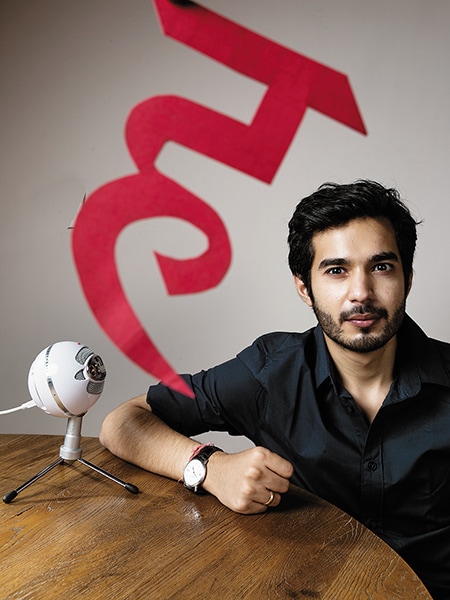 Gautam Raj Anand, CEO of podcast hosting, production and distribution platform Hubhopper, believes audio has an opportunity to capitalise on the time the user is not looking at her phone
Gautam Raj Anand, CEO of podcast hosting, production and distribution platform Hubhopper, believes audio has an opportunity to capitalise on the time the user is not looking at her phone
Image: Madhu Kapparath
Individual content creators on Hubhopper put out at least one episode a week on a regular day. Podcasts being relatively easy to produce, the platform saw an 88 percent increase in content put out by 5,500-plus podcasters during the lockdown, across Hindi, Tamil, Bengali, Telugu and Kannada, Punjabi and English languages. According to Anand, the increasing user base from Tier II and beyond laps up motivational or religious/devotional podcasts, unlike Tier I users, who often listen to audio for upskilling and improving business acumen.
The story of young internet users in India is characterised by an initial frenzied consumption of social media and short videos for instant gratification, says Lal Chand Bisu, co-founder of Kuku FM. “Screen fatigue is real. Over the next three years, they will want to sift through the information deluge, and stick to meaningful content off-screen in order to make their digital lives more productive. Audio will help them there,” he says.
The Mumbai-based startup offers audiobooks, stories, news, academic courses, quizzes and podcasts across various genres in Hindi, Marathi, Gujarati, Bengali and English. The number of users on their platform doubled from 400,000 pre-lockdown to over 800,000 around September, reducing their customer acquisition cost from Rs 8 per instal to Rs 5 per instal.
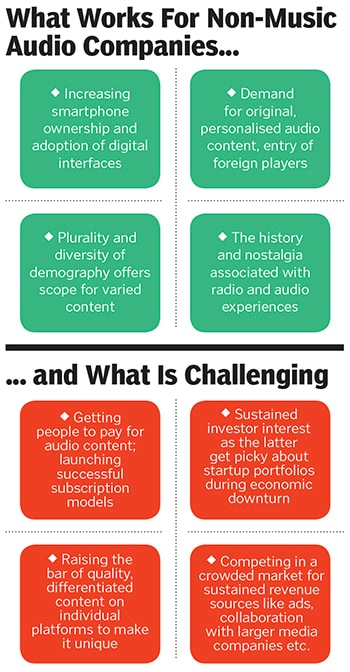
Audio is the natural extension for platforms providing text-based content, believes Jugal Wadhwani, head of audio at Pratilipi FM, which was launched last year as part of Pratilipi, a digital platform that publishes stories in regional languages. In April, the startup raised `76 crore in its Series C round led by Tencent, in which existing investors Omidyar Network, Nexus Venture Partners and Shunwei Capital also participated. Apart from Tencent, the startup has raised about $30 million from various blue-chip backers since its first funding round in February 2018. Pratilipi has been seeing two million daily active users, about 20 percent of whom trickle down to their audio offerings.
A listener typically spends about 22 minutes every day on the platform, Wadhwani says. Pratilipi FM is on-boarding content creators whose text stories have been popular on the main Pratilipi app, apart from engaging independent podcasters. They are putting up audio ranging from news, interviews and story-based podcasts around the Indian Premier League (IPL) to fiction, meditation and mindfulness. “Experimentation is the key content strategy in the industry now. Everybody is trying to build up their markets through interesting formats,” Wadhwani says.
The mood and loyalty of the audience toward a podcast can change depending on their frame of mind and what is happening around them, so it is important for content creators to stay alert and reinvent constantly, says Prathamesh Soni, a Hindi podcaster at Kuku FM, concurring with Wadhwani about experimentation.
“For example, given the tensions associated with Covid-19, everybody wants to listen to happy stories. So one has to balance the sanctity or seriousness of what one wants to offer with some positive messaging, and not sound alarmist,” says Soni. The 28-year-old Mumbai resident has been putting up one podcast every week for the last year-and-a-half but has not made money out of it. He says his chief motivation for the time being is constant engagement with his listeners, most of whom belong to Tier II and Tier III cities.
Where’s The Money?
Most of the startups in the non-music audio space are yet to monetise their offerings, with many formulating subscription plans and revenue channels only now as they acquire more customers. The monetisation strategies mainly include building user habits through personalised and localised content, creating brand awareness, and adopting a creator-led model where individual podcasters will build their own fan base that will in turn be loyal to the platform.
“People in India aren’t completely ready to pay for even videos yet. So creating paywalls without forming a user habit of listening to audio is short-term thinking,” says Anand of Hubhopper, who has raised over $750,000 across four funding rounds since the startup was founded in 2015, with the last fundraise being led by ITI Growth Opportunities Venture Fund in 2019.
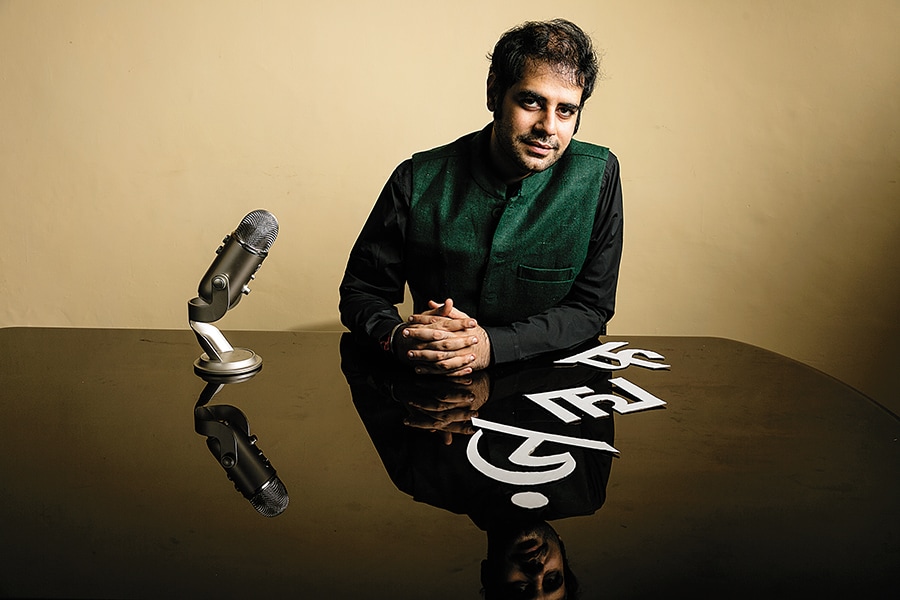 Jugal Wadhwani, head of audio at audio at Pratilipi FM, which is on-boarding content creators whose text stories have been popular on the main Pratilipi app, apart from engaging independent podcasters
Jugal Wadhwani, head of audio at audio at Pratilipi FM, which is on-boarding content creators whose text stories have been popular on the main Pratilipi app, apart from engaging independent podcasters
Image: Madhu Kapparath
Kuku FM, through various online polls and surveys conducted among lakhs of users, has ascertained that people will surely pay for a strong content game. Their subscription model currently in the works starts with Rs 100 per month, Rs 500 for three months and about Rs 900 for an annual subscription.
Bisu realises that the market will get tougher in the wake of Covid-19, with investors tightening their purse strings toward startups that do not make revenue or earn profits. “Monetisation is the biggest problem, but we have been telling our users since we launched [in 2018] that they will soon have to pay for the content, and over 60 percent of our users are willing to pay,” says Bisu, whose startup has raised $6 million in total, with $5.5 million being raised earlier this year in a Series A funding led by Vertex Ventures, in which existing inventors Shunwei Capital, India Quotient and 3one4 Capital also participated.

Most of these platforms are positioning themselves as ‘knowledge providers’, or a natural extension of education, Sharma explains. According to him, during an economic downturn that has resulted in alarming levels of unemployment, youngsters turn to upskilling and motivational content as they seek financial stability. “This is where we saw the trend of users consuming content around jobs, general knowledge, motivation podcasts etc. and we want to provide information that they find valuable in terms of livelihood and skill development,” he says.
Khabri’s monetisation strategy is banking on creating an “influencer economy”, where their most popular content generators will monetise their followers through premium value offerings like live interactions and one-to-one chats. “This would enable micro-transactions on the platform through which the creator earns and we take a part of it. We have estimated a monthly yield of $2 per user through this model,” says Sharma, who plans to roll this out next year. The startup is currently backed by American seed accelerator Y Combinator, Snapdeal co-founders Kunal Bahl and Rohit Bansal of Titan Capital, former Twitter VP Shailesh Rao and other angel investors.
Wadhwani says instead of positioning themselves as an “audio for knowledge” startup, Pratilipi FM is collaborating with creators who produce a wide range of content, including storytelling and entertainment, and is striking partnerships with larger media houses. “Established media companies are experts in creating good content, while we are a distribution platform that can make sure the content reaches an audience of audio listeners. It is a mutual benefit relationship,” he says. He believes that the power and reach of these large media outlets will help the startup and audio consumption itself become more mainstream.
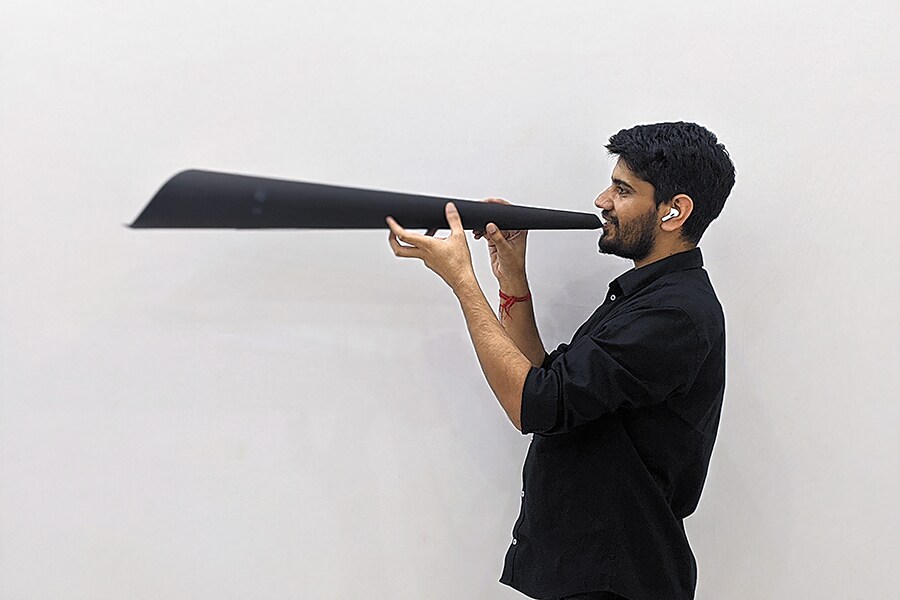 Lal Chand Bisu, co-founder of Kuku FM that creates content in Hindi, Marathi, Gujarati, Bengali and English, is now building a paid subscription model for users
Lal Chand Bisu, co-founder of Kuku FM that creates content in Hindi, Marathi, Gujarati, Bengali and English, is now building a paid subscription model for users
Anand of Hubhopper, much like all other startups in this space, wants to self-sustain and earn profits in the long run. While targeting subscribers and advertising revenue, apart from paid collaborations with media and other companies, he says it is important to “manage capital well and not overreach in anticipation that times are always going to be favourable. Do not hire indiscriminately and try to be as asset-light as possible”.
First Published: Oct 27, 2020, 11:49
Subscribe Now